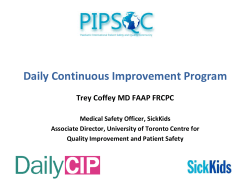
Introduction to Kaizen, Kyosei and Obeya How to be Creative,
Introduction to Kaizen, Kyosei and Obeya How to be Creative, Innovative, Fast & Flexible Dr. John Blakemore Principal Innovation Blakemore Consulting Intrernational National President Manufacturing Society of Australia Advisor to Australian Government on Innovation and Research and Development What is Lean Manufacturing? 1. Lean manufacturing is a Japanese Pull System which maximises throughput and profit with minimum inventory and waste. 2. This method is employed with great success by Toyota, Honda, Canon, Panasonic, and all globally competitive manufacturers. 3. This method employs, Value stream mapping, pull systems, SPC, Six Sigma and other Deming techniques. 4. The key words are OBEYA. KAIZEN & KYOSEI & Kaizen & Kyosei & Obeya • Kaizen = Continuous Improvement • Kyosei = Living and Working Together for the common good • Obeya = Big Room Waste • Expenses (P&L Bal Sheet) • Resources ($,Plant, People, Material etc) • Planning System Aims of Lean Manufacturing 1. Develop a Pull System with Continuous Flow 2. Enhance People skill, flexibility and Teamwork 3. Achieve Shorter Lead Times 4. Have Less Inventory and Waste 5. Use capital more effectively 6. Maximize Value Added 7. Improve Quality 8. Have Less Defective Product and Process 9. Reduced Time to Market for new Products 10.Improve Information and data flow Lessons from The Best Companies in the World 1. John Blakemore in Sept and Oct 2006, visited some of the best companies in the world including, Honda, Toyota, Canon, Mazda, Kawai, Panasonic as part of an investigation to add to our understanding of Lean Manufacture. 2. These lessons can be applied to all manufacturers. 3. To the list of Lean we now need to add Kyosei, (inc Karakuri and the German Meister system). Value Chain Value Creation Service Value Creation Core Process Customer Customer Value Strategic Advantage for Winning Buying Decision People Marketing&Sales Innovation Finance Operations S U P P L Y The Magic of Pull Pull Systems: 1. Reduce and cap Work In Process(WIP) 2. Make by Replacement or MTO 3. Aim at limiting cycle time variability 4. Aim at Continuous WIP (CONWIP) 5. Kanban = linked processes 6. CONWIP = pull from FG Supermarket 7. MRP = push to FG 8. CONWIP is the most Robust System Continuous Flow 1. Once value is added to a product, the product must continue to have value added. 2. No queuing, idle time or stopped flow 3. Remove or speed up the bottlenecks 4. Synchronise…look at a Formula 1 pitstop Minimise Waste Waste can be in the form of : • Material • Time (total, lead etc) • Space • Money • Tampering ( Changing ) • Double Handling • Breakdowns • Band-Aid “Solutions” • Setups, Cleanups, Idle Time, • Inventory (RM, WIP, FG) Japanese Inventory Lead Time Reduction Effectiveness Key Performance 1. Quality, Cost, Delivery (OTD) 2. Lead Times 3. Stock Turns 4. Working Capital 5. Waste % 6. Quality Indices 7. Time to Market 8. Net Tangible Value 9. ROI, RONA, 10. EBIT, VA Pirelli ..Output & Defectives 140 120 100 80 60 40 20 0 Defectives Maximise Value Added 1. Keep the product moving to customer 2. Run Time/ Total Time maximised 3. Maximise use of Tools and Jigs 4. Use clear labels 5. Eliminate non value added steps 6. Push to Pull Value Added PROCESS PARTS (6) 1 1 2 3 4 5 6 2 - 3 4 5 6 Setup(Preparation) Run(The Value Added Step) Maintenance (Preventive) Breakdown(Errors & rework) Idle(available to run but not utilised Cleanup VA = 2,(3)? = Run + Preventive Maintenance Eliminate • Breakdown • Idle • Setup? (→ SMED) • Cleanup → Concurrent Engineering 120 Costs in the Supply Chain Labour A Now B OS Labour C QR 1 D QR 2 100 80 60 40 20 0 Sales Gross Profit Expenses Net Profit Before Tax Manufacturing or Service? There is no such thing as a pure Manufacturing Company All companies are Service Driven The Solution Lean Customer Service Driven •Cooperative Culture •Strong Relationships •Team Cross Functional Structure •High Velocity •Accurate Information •Short Time Periods •Synchronised Processes •Pull not Push •Dynamic not Static Recent Achievements 1. Hazard: 800% productivity gain in 18months 2. Pirelli : Output doubled, NP from –5% sales to 15% profit 3. CSFB: $40M fr WC , OT D 32% to 95%, Loss to $40M EBITA 4. Tannery: Colour defects eliminated from 15% defective 5. Steel Fabricator: Plant redesign, Mat Handling $ halved 6. Computer Supplier: Loss $60,000 to profit $1.0M I year 7. Aluminium Fabricator: Productivity doubled in 6 months 8. Speedo: QR to retailer, inventory down, service up. 9. 14 Plastics Companies: All increased bottom line in 1 yr. 10.Geelong Cement: Productivity Gain of 25% in 6 months 11.Warkworth Mine: Productivity Gain of 16% in 6 Months 12. BHP to PVA: RM Inventory reduced from $1.5M to $60,000 What Has Been Done (Shaw Australia) $300M T/O 25 20 15 10 5 0 -5 July Dec2001 Jan-June2002 Jul-Dec2002 Jan-June2002 Jul-Dec2003 Fcast Lean Production, Pirelli (Italy, Australia) (Loss to Profit then Float) 140 120 100 80 60 40 20 0 Defectives Removing Variation, Cr in Effluent (Saving a Tannery) The End
© Copyright 2025









![Congress story_Chile[1]](http://cdn1.abcdocz.com/store/data/000657373_1-1bcd9d0c73a80d45562dd4951d9e82fb-250x500.png)











